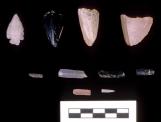1
CONTENTS:- First People of Beringia
- The Microblade People
- Notched Spear Point People
- The White River Ash
2
The First People of BeringiaNobody is sure how long humans have lived in the Carmacks area. During the last Ice Age (before 14,000 years ago), southern and eastern Yukon were covered by glaciers, but central and northern Yukon were free of ice. This ice-free area is known as Beringia, and was home to ancient First Nations people. Carmacks was at the very southern edge of Beringia, surrounded by glaciers. Archaeologists have not yet discovered any artifacts from this period near Carmacks, but there is a good chance that people lived here.
After the Ice Age (about 12,000 years ago), people began moving into places that were once covered by glaciers. Archaeologists call this time the "Northern Cordilleran" period, when people used stone tools like small tear-drop points, large round-bottom spear points, and various scrapers and knives. No archaeological sites from this period have been found around Carmacks (yet), though some have been discovered to the west in Alaska's Tanana River Valley. Melting glaciers at the end of the Ice Age probably washed many old sites away or covered them with sediment.
3
Beringia; ice free area outlined in redDate not available
Beringia
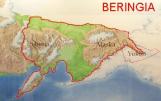 Credits:
Credits:(Courtesy Government of Yukon)
4
Microblades from a site beside Tsalnjik Chú (Nordenskiold River)Date not available
Carmacks, Yukon
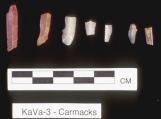 Credits:
Credits:(Courtesy Government of Yukon)
5
The Microblade PeopleAfter about 7000-8000 years ago, the Carmacks area was occupied by those we call the "Microblade People" after their trademark tools. Microblade sites can be found at Tthe Chaew Tagé (Kelly Creek), £utthi Män (Frenchman Lake), and Tsalnjik Chú (Nordenskiold River).
Microblade tools were made by chipping and flaking stone cores in order to make small wedge shapes that were sharp enough for cutting. These blades were usually inserted into a wooden handle of some kind, and could be replaced once they became dull. Microblades were the ancient version of disposable razor blades.
6
Microblade core from Tthe Chaew Tagé siteDate not available
Tthe Chaew Tagé (Kelly Creek)
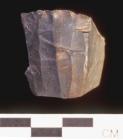 Credits:
Credits:(Courtesy Government of Yukon)
8
Notched Spear Point PeopleAfter about 5000 years ago, new types of tools appear in the archaeological record. These include small stone points with notches for lashing them onto spears, stone scrapers and knives, and hand drills. Archaeologists call this period the "Northern Archaic tradition".
9
Extent of the White River Ash eruption, about 800 A.D.Date not available
Mount Chuchill, Alaska
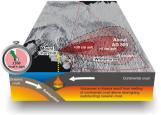 Credits:
Credits:(Courtesy Geoscape Canada)
10
The White River AshAbout 1200 years ago, central and southern Yukon was covered with volcanic ash from the eruption of Mount Churchill near the Alaska/Yukon border. Today, the ash from this eruption (called the White River Ash) can be seen below the topsoil as a white layer that is around 10 cm thick. This is a very valuable dating tool for archaeologists. If they find an artifact below the ash, they automatically know that it is over 1200 years old. If the artifact is above the ash, it must be more recent.
We can only guess what effect the ash-fall had on the people of that time. The animals, fish and plants may have died off. According to knowledge passed down to Elders Susie Skookum and Violet Johnny, the ash covered the tents like snow, and burned when you touched it. People had to go and sit in the water then.
Some think that Yukon people may have fled their homeland to escape the effects of the ash. Today's Navajo and Apache people of the southwestern United States speak a very similar language to Northern Tutchone. According to Elders, these people are the descendants of the people who fled the Yukon after the ash fall.
11
Diorama of life during the White River Ash fall, Tagé Cho Hudän Interpretive Centre1980
Carmacks, Yukon
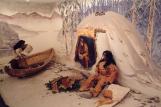 Credits:
Credits:(Courtesy LSCFN)
